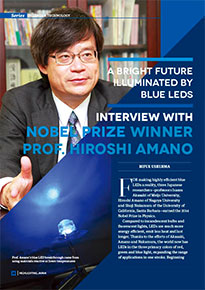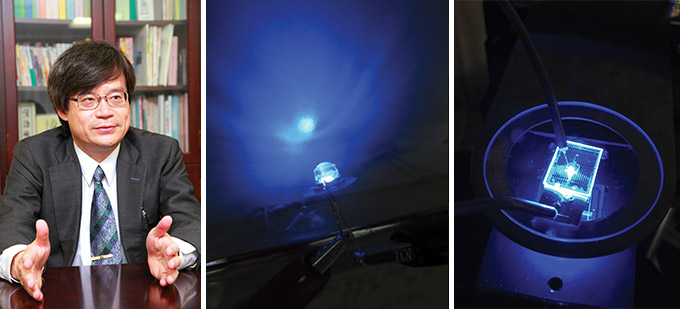Home > Highlighting JAPAN >Highlighting Japan December 2014>Science & Technology
Highlighting JAPAN

Science & Technology
A bright future illuminated by blue LEDs
Interview with Nobel Prize Winner
Prof. Hiroshi Amano

For making highly efficient blue LEDs a reality, three Japanese researchers—professors Isamu Akasaki of Meijo University, Hiroshi Amano of Nagoya University and Shuji Nakamura of the University of California, Santa Barbara—earned the 2014 Nobel Prize in Physics.
Compared to incandescent bulbs and fluorescent lights, LEDs are much more energy efficient, emit less heat and last longer. Thanks to the efforts of Akasaki, Amano and Nakamura, the world now has LEDs in the three primary colors of red, green and blue light, expanding the range of applications in one stroke. Beginning with backlit screens for cellular phones and liquid crystal displays and traffic signal lights, white LED lamps have come into common use in households in just a few years. Violet laser diode based on the same materials also made it possible to create Blu-ray discs, which have a larger capacity than DVDs.
One of the three Nobel laureates, Professor Amano had a specific goal: to be the one who made blue LEDs a reality. With such strong will, he chose the Akasaki Research Center while in his fourth year at university. “But producing blue LEDs was far more difficult than I had ever imagined,” Professor Amano recalls.
Red and green LEDs were developed in the sixties, but no matter how much hard work researchers around the world put in, no one was able to create blue light. The primary bottleneck was the inability to create the crystals that form the light-emitting elements. At the Akasaki Research Center, research was repeatedly conducted focusing on creating gallium nitride crystals, but researchers were unable to produce the large, uniform crystals required.
The breakthrough came during experiments Professor Amano carried out while still a graduate student. To overcome the shortcomings of gallium nitride—which only reacts to high temperatures and high pressure—he grew crystals on an aluminum nitride layer reactive at low temperatures sandwiched between a substrate and gallium nitride. In doing so, he succeeded in creating the crystals that would become the elements for the world’s first blue LEDs.
“It was my research over a span of six years as a graduate student, from age 24 to about 29, which became the basis for this prize,” says Professor Amano. “I hope the fact that such achievements during my youth were recognized and earned the Nobel Prize will serve as an inspiration for today’s young researchers.”
LED lights currently have a maximum energy efficiency of 60 percent, making them several times more efficient than incandescent light bulbs. However, the remaining 40 percent of non-light energy is emitted as heat. And since LEDs produce a large amount of electrical current in tiny spaces, while each unit consumes only a small amount of energy, the energy density is extremely high. The resulting high heat is a shortcoming that affects surface-mounted components and leads to higher product costs.
While LEDs are much cheaper compared to a few years ago, Professor Amano says they still remain expensive. “The driving force behind my research is to be of service to people,” he observes, “but LEDs are still too high-priced to make them available for people all over the world to use. So our goal is to make the cost of LEDs one-fifth of today’s prices by 2020. We are busy researching ways to increase energy efficiency.”
When asked what attracts him to LED research, Professor Amano replies with a twinkle in his eye: “The fact that when we create something, it will always shine.” Even after winning the Nobel Prize, his mindset as a researcher remains unchanged, always believing in a brighter future illuminated by LEDs.
© 2009 Cabinet Office, Government of Japan






